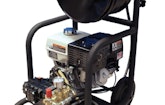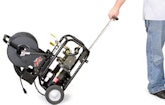Interested in Cleaning?
Get Cleaning articles, news and videos right in your inbox! Sign up now.
Cleaning + Get AlertsFor those blockages that are just too tough to clear with a cable drain cleaning machine, the next best tool is a water jetter.
“In the past cable drain cleaning machines were all that was available,” says Marty Silverman, vice president of marketing for General Pipe Cleaners. “They do a great job of cutting roots and debris and retrieving objects out of the drainline, but they have always had a hard time with certain kinds of stoppages.”
The main type of stoppage that was difficult to remove was grease, according to Silverman.
“The cable goes in and whips around, but it doesn’t clear the grease out, instead the grease closes up behind the cable,” Silverman says. This is known as a self-healing stoppage. “Stoppages like these were a problem until jets came along.”
High-pressure water does the job
Water jetters use high-pressure water to cut the grease off the walls of the pipe and the water flushes the line clear. Jets also do a better job of clearing sand out of the line and dealing with a stubborn wintertime stoppage — ice.
“When you have to deal with a frozen line a cable can’t cut through the ice, but water can,” Silverman says. “It doesn’t even have to be hot water to melt the ice. At four gallons per minute, you can melt the ice at about a foot per minute, even with cold water.”
Silverman says those looking to purchase a water jetter have a couple things they should consider. The first should be what kinds of lines need to be cleared — specifically the length and diameter. Generally, longer lines and larger diameter pipes require more pressure and water flow.
“Also, you want to look at where the drain is, inside the building or outside on the street,” Silverman says. “Inside the building you might go with an electric jet, but you’re limited on pressure and flow rate with electric jets.”
One such electric option is the Model 717 hydrojetter from Spartan Tool. The portable system includes an adjustable pressure regulator and three standard hoses that allow cleaning out to 165 feet.
Another option, according to Silverman, is a gas-powered jet. “You can get a separate hose reel so you can leave the fumes of the gas machine outside but use the power of the gas machine inside,” he says. “Just pull the hose inside and use the smaller reel to clear the line.”
For clearing large, remote lines of grease, sediment, ice and other soft blockages, check out the JM-3080 water jet from General Pipe Cleaners. The unit offers 8 gpm at 3,000 psi with Vibra-Pulse to propel nozzles through long lines and tight bends.
If you’re looking for a smaller jetter, the PJ-3000 from Draincables Direct includes a 13 hp Honda gas motor with a robust but small frame that provides 4 gpm at 3,000 psi, while the Shark SJPE-1500 electric jetter from Shark Pressure Washers & Jetters offers Pulse Technology that propels hose through lines and around tight curves to break through clogs.
Jetter evolution
Jetter technology hasn’t changed considerably over the years — the biggest changes have come with the pumps and the nozzles.
“Pump manufacturers have beefed up their designs so they are more durable and can handle freezing without major damage,” Silverman says. “Nozzles have changed and are more efficient. We use high-efficiency nozzles.”
Silverman says the electric-powered machines are the most popular of General Pipe Cleaners’ jetters.
“Our big advantage is we’re able to maintain the same pressure and flow rate whether the pulse is on or off,” Silverman says. “In a small jet you don’t have as much pressure or flow, so you really need help to get the hose around the bends. The pulsation of the hose helps it vibrate and overcome the friction in the line and puts the hose further down the line.”
(All equipment listings from Cleaner Product Focus, November 2012)









